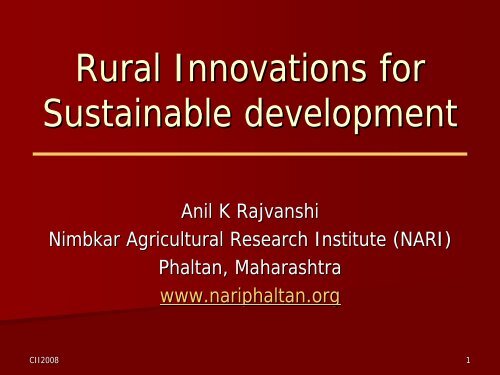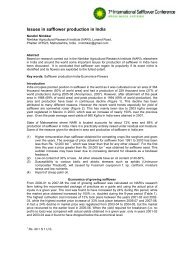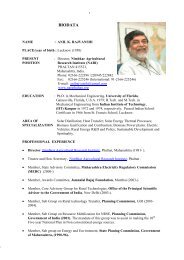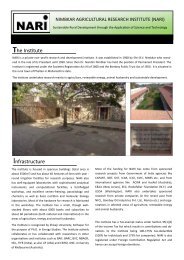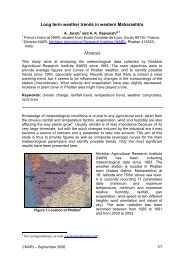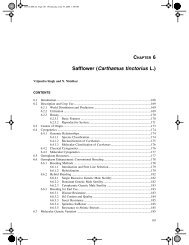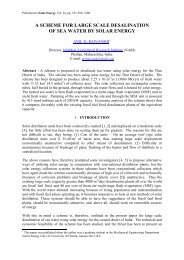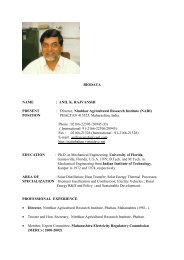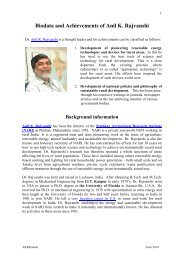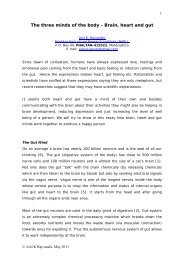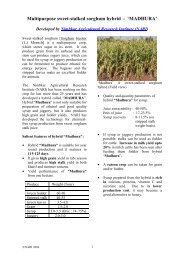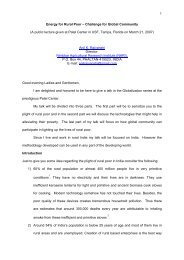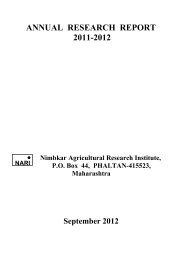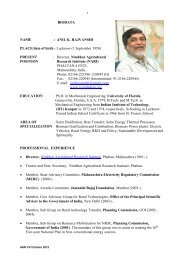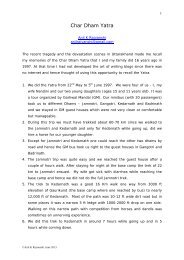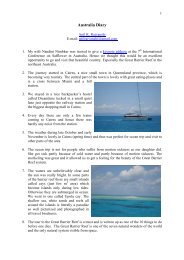Rural Innovations for Sustainable development - NARI
Rural Innovations for Sustainable development - NARI
Rural Innovations for Sustainable development - NARI
You also want an ePaper? Increase the reach of your titles
YUMPU automatically turns print PDFs into web optimized ePapers that Google loves.
<strong>Rural</strong> <strong>Innovations</strong> <strong>for</strong><br />
<strong>Sustainable</strong> <strong>development</strong><br />
Anil K Rajvanshi<br />
Nimbkar Agricultural Research Institute (<strong>NARI</strong>)<br />
Phaltan, Maharashtra<br />
www.nariphaltan.org<br />
CII2008 1
Introduction<br />
• <strong>Innovations</strong> <strong>for</strong> creating wealth<br />
• <strong>Innovations</strong> in farming and rural employment<br />
• Both possible through energy from agriculture<br />
• Energy and food security to be maximized<br />
• Energy is the basis of life. Lack of it produces economic<br />
stagnation and social upheavals<br />
• Energy from agriculture will provide rural wealth and<br />
create employment. Can bring 60% marginalized people<br />
into mainstream India, without which India cannot<br />
become an economic superpower<br />
CII2008 2
Energy from Agriculture<br />
• India produces ~ 600 million tons of agri. residues per<br />
year. Waste disposal problem and hence mostly burned in<br />
fields . Creates environmental pollution and loss of energy.<br />
• From special crops and residues we can produce three<br />
types of fuel<br />
– Liquid fuels like ethanol, biodiesel or pyrolysis oil.<br />
– Gaseous fuel like methane (biogas).<br />
– Electricity via biomass-based based power plants.<br />
• Can take care of major fuel requirements of India.<br />
• In any agriculture 25-40% of produce is food and rest are<br />
residues. No remunerations from residues, hence farming<br />
is uneconomical. No industry can survive on such norms.<br />
• Residues <strong>for</strong> energy can give an extra income of Rs. 2000-<br />
4000/acre/season to the farmers. Insurance against<br />
distress sale.<br />
CII2008 3
Energy production (cont..)<br />
• Residues can produce 156 b l/yr of ethanol which is<br />
42% of India’s s oil demand in 2012; or 80% of oil<br />
demand via pyrolysis oil; or 80,000 MW of electric<br />
power (50% of installed capacity).<br />
• Can provide 120 million jobs.<br />
• With increased industrial demand<br />
<strong>for</strong> fuel and electricity large tracts<br />
of farmlands may come under fuel<br />
crops only.<br />
• Food vs. fuel debate. Need to do<br />
R&D on multipurpose crops.<br />
• <strong>NARI</strong>’s s pioneering work on sweet sorghum.<br />
• Farms and farmers are the backbone of any nation<br />
since they can produce food, fuel and wealth from<br />
the land. <strong>Innovations</strong> needed <strong>for</strong> them.<br />
CII2008 4
<strong>Innovations</strong> in cooking and lighting<br />
• Increased wealth through energy production<br />
from agriculture is the engine of <strong>development</strong>.<br />
• High technology needed to provide energy<br />
devices in rural areas.<br />
• High technology provides increased efficiency of<br />
devices so useful outputs are obtained from<br />
dilute <strong>for</strong>ms of energy.<br />
• Around 75% of total energy is used in rural<br />
cooking and lighting. <strong>Innovations</strong> in these areas<br />
can improve the quality of life.<br />
CII2008 5
Cooking/lighting on ethanol<br />
• Only renewable liquid and gaseous<br />
fuels can provide clean household<br />
energy.<br />
• 50% ethanol/water mixture. Easy<br />
to distill and very safe household<br />
fuel.<br />
• Stoves and lanterns developed.<br />
• Stove 2.5-3 3 kW capacity. Like LPG<br />
stove with high and simmer<br />
settings.<br />
• Lantern output =100 W bulb light.<br />
• Need to change draconian excise<br />
laws.<br />
• www.nariphaltan.org/ethstove.pdf<br />
CII2008 6
Biomass Gasification<br />
• Loose leafy biomass gasifier.<br />
• 500-800 kW (thermal)<br />
capacity. Controllable flame.<br />
• Cleaning of gas still a problem.<br />
• http://nariphaltan.virtualave.net/Gasi<br />
fier.pdf<br />
CII2008 7
Environmentally sound transport<br />
• Electric cycle rickshaws<br />
• Trikes <strong>for</strong> handicapped<br />
• Electric auto rickshaw.<br />
• http://nariphaltan.virtualave.net/MAPRA.pdf<br />
CII2008 8
Availability of devices in rural areas<br />
• “Cell phone model” to be used. Provides an<br />
important function <strong>for</strong> communication in rural<br />
areas. Is robust, very high tech, low cost and<br />
good after sales service. So are human beings!<br />
• Biomimicry should be the mantra <strong>for</strong> rural R&D.<br />
• Need <strong>for</strong> corporate world, civil society (S&T<br />
NGOs) and rural population to work together.<br />
• <strong>Innovations</strong> are needed in corporate/NGO<br />
partnership. <strong>NARI</strong>/NFCL example.<br />
CII2008 9
Role of Corporate World<br />
• Corporate World should be directly involved in rural<br />
<strong>development</strong>. Have managerial and other resources.<br />
• In energy production via renewables:<br />
– Power production<br />
– Utilities <strong>for</strong> liquid and gaseous fuels. Fuel<br />
production either with dedicated crops or residues<br />
• Water utilities in a village using rain water harvesting<br />
and supply <strong>for</strong> both irrigation and household uses.<br />
Need <strong>for</strong> water Act similar to Electricity Act.<br />
• Need to look beyond business and financial gains<br />
only. <strong>Rural</strong> energy industry could be Rs.50 K cr/yr.<br />
• Need to reduce profit margins <strong>for</strong> rural work.<br />
CII2008 10
Corporate World (cont..)<br />
• In this era of enhanced communication, creation of rural wealth<br />
is in the interest of corporate India.<br />
• The captains of corporate world need to reduce their<br />
consumptive lifestyle. It is unsustainable.<br />
• A decent lifestyle is possible with energy consumption of 50-70<br />
GJ/person/yr. In India avg. consumption is 18 GJ/person/yr. In<br />
US it is 350 GJ/person/yr.<br />
• If every citizen of the India follows US lifestyle we will need all<br />
the resources of the world to sustain it.<br />
• Spirituality can help in curbing the greed and making us<br />
sustainable.<br />
• Becoming sustainable in our personal lives and giving<br />
something back to the society will help India become a holistic<br />
and sustainable country.<br />
CII2008 11
Thank You<br />
Useful sites<br />
• www.nariphaltan.org<br />
• www.nariphaltan.org/writings.htm<br />
(articles on spirituality, technology and<br />
sustainability)<br />
• www.nariphaltan.org/langmuirrural.pdf<br />
(an article on use of high technology <strong>for</strong> rural<br />
areas)<br />
CII2008 12


